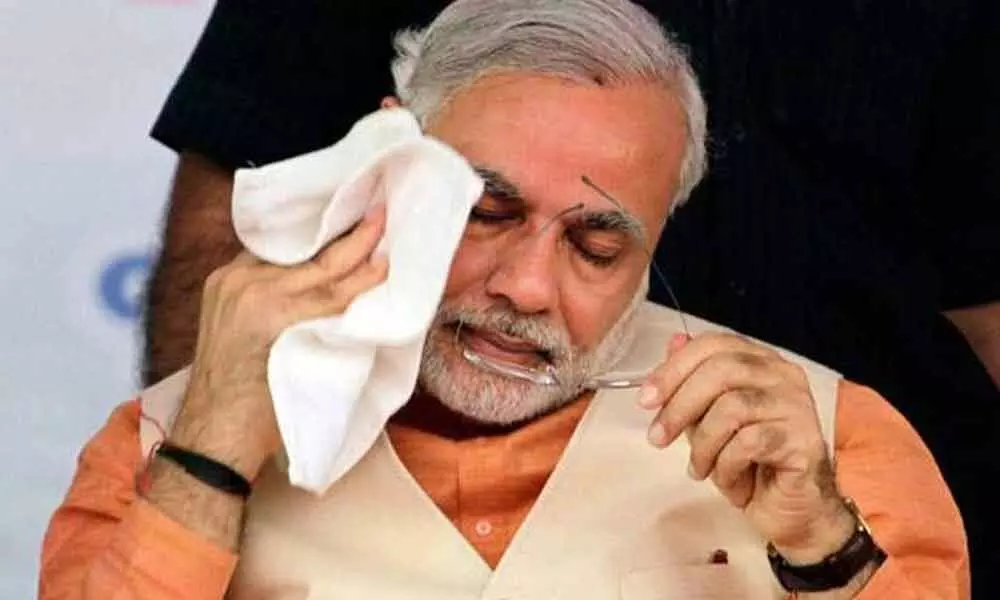Live
- AAP increases pension reach by 80,000
- R Sadasivam takes charge as Nayi Brahmin corporation chief
- BRS District-Level Preparatory Meeting Today in Sircilla
- Ghose Commn grills 14 irrigation officials over Medigadda damage
- SCCL to open 7 coal mines in 5 years: Kishan Reddy
- Campaign on elimination of violence against women launched
- Youth Cong demands Adani's arrest
- HC seeks Centre's response on girl's plea to expedite rare disease treatment
- 5 dead, 4 injured in Hardoi road accident
- TTD makes preparation for vaikuntha ekadashi to be held from January 10
Just In
Pundits smell chance for regional parties say in national politics


Narendra Modi
With the results of five assembly polls delivering a chastening blow to BJP's electoral juggernaut and virtually decimating its main rival Congress, West Bengal Chief Minister Mamata Banerjee's massive victory over the formidable saffron machinery may help bring regional satraps to the fore of the national politics yet again, analysts believe.
New Delhi: With the results of five assembly polls delivering a chastening blow to BJP's electoral juggernaut and virtually decimating its main rival Congress, West Bengal Chief Minister Mamata Banerjee's massive victory over the formidable saffron machinery may help bring regional satraps to the fore of the national politics yet again, analysts believe.
Under flak from the opposition for its government's handling of the Covid-19 crisis, the BJP's big loss in West Bengal polls has denied the party a face-saver it might have hoped for to claim the popular endorsement for its policies and has lent further ballast to the view that it often falls short against a popular regional force. While the BJP will draw some satisfaction from its comfortable win in Assam, the overall mood in the party was sombre as it appeared drawing a blank in Kerala and also fared poorly in Tamil Nadu where its senior ally AIADMK was set to lose power to the rival DMK but defied some exit poll predictions of its rout. The BJP-led NDA, however, trumped its rivals in Puducherry. BJP sources claimed that a meltdown of the Left-Congress alliance, consolidation of Muslim votes behind Banerjee-headed Trinamool Congress, and a fall in the polling percentage, especially in the last few phases as the Covid-19 cases surged, played a role in its defeat. The saffron party's West Bengal unit chief Dilip Ghosh, however, said that the leaders who came to BJP from Trinamool somehow did not fare well in the elections, while another senior party leader Kailash Vijayvargiya credited Banerjee for the TMC's astounding performance.
Manindra Nath Thakur, an associate professor at the Centre for Political Studies of JNU, said the West Bengal results may trigger a new realignment with Banerjee, whom he described as the strongest woman leader after Indira Gandhi, emerging as a key force. Noting that she does have a party structure outside Bengal, he said the second phase of coalition politics may emerge with regional satraps playing a strong role.
The Congress will have a role in states where it remains strong, he added. The regional forces used to have a significant presence in the national politics till 2014 when Prime Minister Narendra Modi steered BJP to its maiden majority in Lok Sabha polls diminishing the say of state satraps in power corridors of the national capital. Even in defeat, a BJP leader said, the party emerged as the only capable challenger to Banerjee. "From three seats (2016), we now have nearly 90 MLAs. Analysts will write whatever they have to but the BJP is now an obvious alternative to the TMC, which was not the case until a few years back," he said. Thakur also noted that Bengal is now "between the BJP and Mamata" with the Left and the Congress having been wiped out. "The BJP has gained ground in the state. With the kind of party structure and resources it has, it may create problems for her in the next five years," he said.
However, judged against its rhetoric of winning over 200 seats, such is the scale of the BJP's loss that it was reminiscent for some of its drubbing in the 2015 Bihar assembly polls where it was simply no match to the popular support the RJD-JD(U) alliance enjoyed despite its high-decibel campaign. According to the Election Commission's data, the gap between the TMC and the BJP vote share was almost 10 per cent. This meant a loss of nearly 3 per cent for the saffron party and a gain of about 5 per cent for the TMC since the 2019 Lok Sabha elections.

© 2024 Hyderabad Media House Limited/The Hans India. All rights reserved. Powered by hocalwire.com






